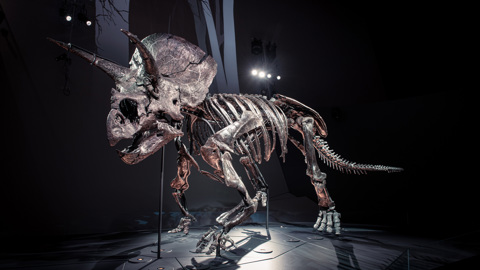
Dinosaur Walk Gallery Visit
Walk among the skeletons of amazing animals from the past.
See how prehistoric animals lived and get up close to skeletons of dinosaurs and giant extinct megafauna.
Students will experience
- An incredible diversity of dinosaur skeletons including enormous long-necked dinosaurs, terrifying carnivores, tenacious tiny herbivores, the armoured ankylosaurs and more!
- Videos of palaeontologists explaining key dinosaur facts such as: how dinosaurs evolved from birds, why Tarbosaurus was such an efficient killer, what dinosaur eggs can tell us about their life cycles, and what we know about Megafauna.
- Giant extinct Australian megafauna.
- Amazing scientific replicas of the dinosaur teeth and skulls, which students can touch and examine to learn about the structural features that helped creatures to survive.
- Multimedia interactives that demonstrate how these animals moved, ate, and survived.
Students will learn
- Dinosaurs have observable features that can be used to group them in different ways.
- Living things, including dinosaurs, have characteristics that distinguish them from non-living things.
- Dinosaurs have evolved over time, as shown by fossils records.
- The structural features of dinosaurs enabled them to thrive in their environments.
- There are similarities and differences within and between dinosaurs.
Related links
Availability
Terms 1–4, Monday to Friday
Student information
Years K to 10
Bookings
Call 13 11 02 or submit an online booking request
Exhibition
Self-guided exhibition visit
Victorian Curriculum Links
Science: Foundation to Level 2
Biological Sciences
- plants and animals have observable features that can be used to group them in different ways
(VC2S2U01)
Science: Levels 3 and 4
Biological Sciences
- living things have characteristics that distinguish them from non-living things and things that were once living, including fossils
(VC2S4U01)
Science: Levels 5 and 6
Biological Sciences
- organisms have evolved over time, as seen in fossils and scientific records; the structural features and behaviours of living organisms enable them to thrive in their environments
(VC2S6U02)
Science: Levels 7 and 8
Biological Sciences
- there are similarities and differences within and between groups of organisms living on Earth; the development and use of classification tools, including dichotomous keys, help order and organise human understanding of the diversity of life (VC2S8U01)
Accessibility
Please view our accessibility page for general information. Contact our team on 13 11 02 or email us at [email protected] to discuss how we can support your visit.
Museums Victoria Learning Access Fund
The Museums Victoria Learning Access Fund aims to enhance access to our museums (Melbourne Museum, Scienceworks and Immigration Museum), programs and events by offering free or subsidised education programs for eligible schools. Find out more about the fund.

Sign-up to Museum Teachers
Subscribe and get special offers, teacher news and free entry to all museums.










